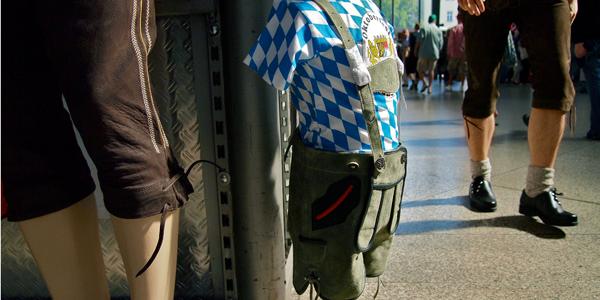Old is New Again in Bavaria
Pairs of Lederhosen stand for sale at Munich’s main rail station. During the 17-day Oktoberfest, the traditional Lederhosen and Dirndl become ubiquitous in Munich. (Photo: Tom Dreisbach)
By Tom Dreisbach
Munich’s Oktoberfest is in full swing as it heads into its final weekend. About six million people visit the annual celebration of Bavarian culture and beer. This year, traditional Bavarian clothing seems especially popular. More men are wearing lederhosen — leather pants or shorts with suspenders — and women are in dirndls, the traditional milk-maid dresses.
The growing popularity may owe something to Daniel Welte, a salesman at Wies’n Tracht und Mehr, a store in central Munich that specializes in classic Bavarian clothing.
Welte exudes Bavarian; he has a long black mustache that curls up at each end and a thin triangle of a goatee. And, of course, he wears his lederhosen religiously.
“If I go on holiday in Spain, I wear my leder trousers,” Welte says.
In the narrow store, Welte’s large white dog, Rocco, dozes behind the cash register as the staff serve customers glasses of sparkling wine. The shop marries modern and traditional — for instance, the lederhosen come in a “hot pants” version for women.
Welte says the crowds in the shop have gotten bigger in recent years, as more people embrace Bavarian tradition.
“I think it’s because the dresses are getting cheaper. In the old time, the Bavarian dirndls started around 500-600 Euros,” he says, adding that now younger customers can buy them. A good pair of lederhosen can still cost up to 600 Euros, about $800. But cheaper versions are now available.
Franziska Dygutsch, 20, is already wearing a dirndl. She’s shopping in Welte’s store for the right necklace for Oktoberfest. She says the traditional clothes make the Fest.
“Not everybody, but most of them wear it,” Dygutsch says. “And when you don’t have one, you’re an outsider.”
Her friend, Sabrina Roth, agrees, and even calls dirndls “sexy.”
“People think, ‘yes, it’s cool,'” she says, “because everyone thinks they want ‘back to the roots’.”
Stefan Reiss, a 60-year-old lawyer from Berlin, is also looking around the shop. He grew up in the years after World War II, a time when Germans stayed away from traditional dress, in part because it smacked of Nazi-conformity.
“You didn’t wear formal things when you went to work in my generation,” says Reiss. “You wanted to have a break, and you wanted to show that you were you originally.”
He added that growing up in post-war Germany left him with deep neuroses about German identity, something younger generations seem to be free of.
“I see the positive aspect,” he says, referring to the return to classic Bavarian garb. “Though it’s strange to me.”
He says he’ll continue to leave the lederhosen to everyone else.
